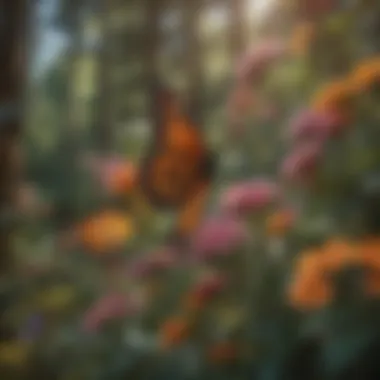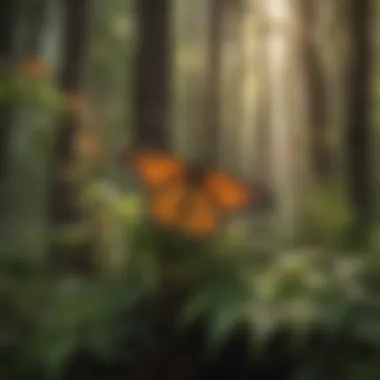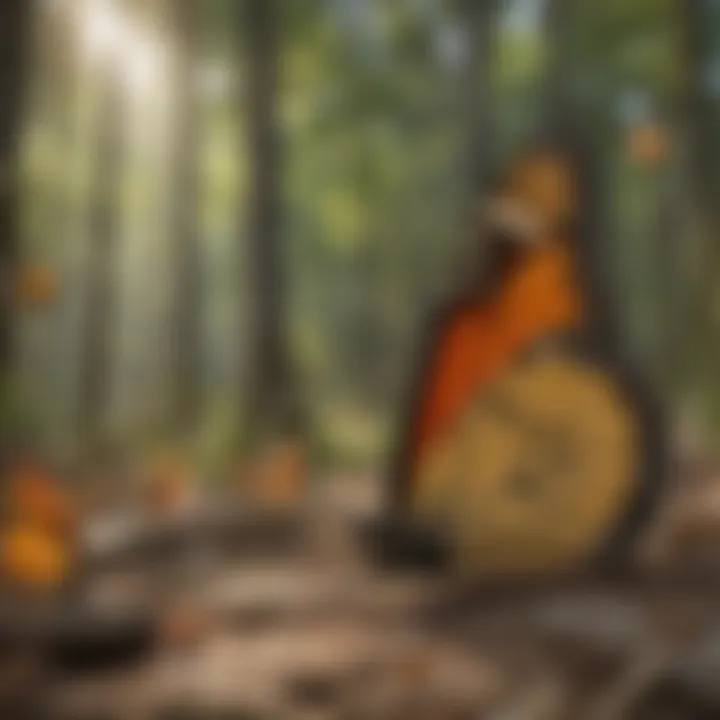The Impact of Monarch Butterflies on Pollination


Intro
When it comes to the grand tapestry of nature, each thread plays its part. One thread, often overlooked yet crucial, is the role of monarch butterflies in the ecosystem, particularly in the pollination process. These vibrant insects, with their stunning orange and black wings, don’t just catch the eye; they also contribute to the health of numerous floral species. Conservationists, scientists, and everyday nature enthusiasts all emphasize the importance of understanding how these butterflies interact with the plants around them.
This article sets out to highlight the significant role monarchs play in pollination, the challenges they face due to habitat loss, and the pressing need for conservation. By taking a closer look at their interactions with various flowers, we gain insight into the broader implications of biodiversity and ecosystem balance. Monarch butterflies are not merely beautiful to observe; they are a linchpin in sustaining ecosystems.
As we delve into this topic, we will unpack the intricate relationships between monarchs and plants, the impact of declining habitats, and actionable conservation strategies. Our goal is to foster a deeper understanding of these butterflies' contributions to our environment—a crucial step in rallying community support for their conservation.
With the looming threat of climate change and increasing urbanization, knowledge and action are more vital than ever. This narrative isn't just about butterflies; it’s a call to all of us to recognize our interconnectedness with nature. Let's journey together through the vibrant yet fragile world of monarch butterflies, exploring their essential role in pollination.
Prologue to Monarch Butterflies
Monarch butterflies are not just a pretty sight fluttering by; they play a crucial role in maintaining the health of ecosystems. This section serves as an entry point into understanding their significance, especially in the context of pollination. Recognizing the traits and behavior of these vibrant insects lays the foundation for discussing their interactions with plants, which are vital for sustaining biodiversity.
Their presence in various ecosystems represents a delicate balance; they aid in the reproduction of many flowering plants, which in turn supports countless other organisms. Understanding the intricacies of monarch butterflies is imperative for grasping the broader implications of pollination-related activities. This sets the stage for deeper inquiries into how they contribute to our ecological networks.
Overview of Monarch Butterfly Characteristics
Monarch butterflies are known for their impressive orange and black wing patterns. Each adult butterfly typically measures 3 to 4 inches across, making them easily identifiable. The bright colors serve a dual purpose: they attract potential mates and ward off predators, as many creatures associate those hues with toxicity. Monarchs are also equipped with a unique structure known as a proboscis, which enables them to extract nectar from flowers effectively.
Monarchs undergo a fascinating transformation—starting as tiny eggs laid on milkweed plants, they progress through larval (caterpillar), pupal (chrysalis), and adult stages. This metamorphosis not only highlights their remarkable resilience but also emphasizes their dependency on specific plants throughout their life cycle. Furthermore, their migratory behavior is legendary.
Life Cycle and Migration Patterns
The life cycle of the monarch butterfly is a testament to nature's intricate design. After hatching from eggs in about 10 days, the larvae consume milkweed voraciously, which prepares them for the next stages of life. Generally, they undergo five instars, shedding their skin as they grow. This feeding phase lasts roughly two weeks, before they pupate into chrysalises, a process that can take 10 days to two weeks.
Migration is perhaps the most striking aspect of the monarch’s behavior. Each year, millions embark on an arduous journey from North America to central Mexico to escape the cold winter. These butterflies cover thousands of miles, navigating through changing landscapes with astonishing accuracy.
This remarkable migration is not just a seasonal routine; it is critical to their survival and reproductive success. With the dormancy period spent in warmer climates, they return in spring to lay eggs for the next generation, ensuring the cycle continues. Monarchs face many challenges along the way, including habitat loss, climate changes, and pesticide use, all of which threaten their existence. Thus, understanding their life cycle and migration is vital for conservation efforts and highlights the need for protective measures.
Understanding Pollination
Pollination is a critical ecological process that ensures the reproduction of flowering plants. This aspect forms the foundation for various ecosystems as it links plant species with the myriad of species that rely on these plants for food and habitat. The significance of understanding pollination within the context of monarch butterflies cannot be overstated. Monarchs not only contribute to this process but also serve as indicators of environmental health. The pollination facilitated by these butterflies fosters biodiversity, enhances food production, and contributes to the overall stability of ecosystems.
Highlighting the relationship between monarch butterflies and plants reveals vital aspects of pollination. The monarch's distinct life cycle and migration patterns coincide with the blooming of several key plant species. As they migrate, they engage with various flowers, facilitating the transfer of pollen. This simple act significantly boosts the reproductive success of many plant species, which in turn supports entire food webs.
The Process of Pollination
In its essence, pollination involves the transfer of pollen from the male parts of a flower (the anthers) to the female parts (the stigma) of the same or another flower. This transfer can occur through various means: wind, water, or animal involvement. Monarch butterflies, with their encoded instincts and behaviors, play an indispensable role in this process.
As they flit about gardens and meadows, they sip nectar from flowers. In doing so, they brush against anthers and inadvertently collect pollen grains. When they visit another flower to feed, this pollen is deposited on the stigma, completing the act of pollination. It's almost like a well-rehearsed dance between the butterflies and the flora—each partner playing its role to promote life.
Monarchs are particularly attuned to bright colors, most notably orange and yellow, which often indicate a high nectar yield. Their specialized proboscis allows them to extract nectar with remarkable dexterity, encouraging them to visit multiple flowers in one foraging trip, thereby spreading pollen over a broader area.
"In a single afternoon, one monarch can visit dozens of flowers, a small feat with tremendous ecological implications."
This robust interaction enriches ecosystems, enhancing genetic diversity among plants and increasing the resilience of plant communities to pests and diseases.


Types of Pollinators: A Comparative Analysis
While monarch butterflies are effective pollinators, they are just one part of a larger mosaic of life involved in this vital process. Examining various types of pollinators reveals how each has unique adaptations that allow them to perform their roles:
- Bees: Perhaps the most well-known pollinators, bees have evolved fuzzy bodies that effectively capture and transfer pollen. They are particularly efficient and can visit many flowers in a short amount of time.
- Hummingbirds: These birds are attracted to tubular flowers rich in nectar. Their ability to hover allows them to reach deep into flowers, leading to effective pollen transfer.
- Wind: Wind-pollination is more common in grasses and trees, where pollen is released into the air to fertilize flowers without animal assistance.
- Bats: In certain regions, bats act as crucial night-time pollinators, favoring large, fragrant flowers that bloom at night.
Each of these pollinators has a distinct role in maintaining ecosystem balance, with monarch butterflies adding a layer of complexity due to their specific preferences for certain nectar-rich flowers. Understanding the interactions among these various pollinators and their targets is crucial for effective conservation strategies, especially considering the challenges faced by both insects and plants in changing environments.
By delving into the mechanics of pollination and the roles different pollinators play, it becomes clear that maintaining a healthy population of monarchs is integral not only for biodiversity but also for the productivity of agricultural systems and the sustainability of ecosystems worldwide.
In essence, the intricate dance of pollination showcases the interconnectedness of life and underscores the importance of conservation efforts aimed at protecting these essential worker bees—and butterflies.
Monarch Butterflies as Pollinators
Pollination is a vital ecological process that sustains plant reproduction and, in turn, the health of larger ecosystems. Monarch butterflies do not just flutter gracefully across landscapes; they play a critical role in this process. These stunning insects facilitate the growth of numerous flowering plants, which serve as food sources and habitats for various wildlife.
Monarchs contribute to pollination primarily due to their foraging behavior. As they migrate and search for nectar, they inadvertently transfer pollen from one flower to another, allowing plants to produce seeds and fruit. This action is paramount as many plants rely on animal pollinators to thrive, especially those with specific floral structures that necessitate certain types of pollinators. Furthermore, the vibrant color scheme of monarchs attracts other species of insects, creating a synergistic effect that amplifies the pollination process across various plant species.
Species of Flowers Visited by Monarchs
Monarchs are particularly attracted to specific flower species that provide the nectar they require. They often visit:
- Milkweed: Monarchs are strongly associated with different types of milkweed. Not only do they feed on its nectar, but this flower is also crucial for their life cycle, as it is the only plant where they lay their eggs.
- Asters: These colorful flowers bloom in the fall, providing a critical late-season nectar source.
- Goldenrods: Rich in nectar, goldenrods are often buzzing with activity during migration season, attracting a variety of pollinators, including monarchs.
- Joe Pye weed: Another favorite, known for its tall stature and fluffy flower heads, Joe Pye weed offers abundant nectar during late summer.
In addition to these, monarchs are drawn to other various wildflowers and cultivated garden plants that have a rich nectar supply. By visiting these flowers, monarchs assist in the reproductive cycles of many species, thereby enhancing biodiversity in their habitats.
Mechanisms of Nectar Extraction and Pollen Transfer
Monarch butterflies exhibit unique mechanisms for nectar extraction, which in turn facilitates pollen transfer. Their long proboscis allows them to reach into tubular flowers, exemplifying their role in a specific mutualistic relationship with plants. As monarchs sip nectar, they brush up against the anthers of the flower, collecting sticky pollen grains on their bodies.
When they move to another flower, they unwittingly transfer this pollen to the stigma, thus enabling fertilization. This process is not merely incidental; research indicates that monarchs, due to their size and flight patterns, are effective pollinators, often moving more pollen than smaller insects might.
Moreover, the foraging behavior of monarchs also influences the flowering patterns of plants. When flowers produce more nectar, they may attract even more monarchs, establishing a feedback loop that benefits both butterfly populations and the health of blooming landscapes.
"The interdependence between monarch butterflies and flowering plants illustrates a complex web of life where the actions of one species can lead to the flourishing of many others."
The Ecological Significance of Monarch Pollination
Pollination plays a crucial role in maintaining healthy ecosystems, and monarch butterflies are vital players in this environmental theatre. These striking insects not only contribute to the pollination of various plants but also support the overall biodiversity that sustains life on Earth. The ecological significance of monarch pollination can be explored from different angles, revealing the multifaceted benefits that flow from their interactions with flowering plants.
Contribution to Biodiversity
Monarch butterflies are not just exquisite creatures; they are a linchpin in the tapestry of floral biodiversity. As they flutter from flower to flower, they aid in the reproduction of numerous plant species, which ultimately supports a diverse range of wildlife. For instance, species such as milkweed, a critical food source for monarch larvae, rely on these butterflies to cross-pollinate. The seeds produced as a result further propagate these plants, enriching the habitats in which they grow.
“Without pollinators like monarchs, many plants that wildlife depend on could dwindle or disappear altogether.”
Their role extends beyond mere pollination. Monarchs have a hand in shaping the very composition of plant communities. By favoring the flowering plants they visit most, these butterflies influence which species can thrive in particular areas. This shaping can lead to a more resilient ecosystem that can better adapt to changes such as climate fluctuations or disease outbreaks. In turn, these changes foster a wider range of species that rely on a rich variety of plants for food and shelter.
Impacts on Ecosystem Functioning


The impact monarch butterflies have on ecosystem functioning goes hand-in-hand with their role in biodiversity. By promoting pollination, monarchs help ensure that plant populations remain robust and productive. This productivity has a ripple effect throughout the food web. For example, more flowers lead to more insect herbivores, which in turn support a plethora of birds, mammals, and other predators.
Moreover, the plants nourished by monarch pollination contribute to several ecosystem functions:
- Carbon Sequestration: Plants absorb carbon dioxide, helping mitigate the effects of climate change.
- Soil Health: Robust plant life aids in maintaining nutrient-rich soils, preventing erosion and supporting other flora and fauna.
- Water Regulation: A diverse plant system can better manage water retention and drainage within ecosystems, preventing flooding and maintaining hydrological cycles.
In summary, the pollination efforts of monarch butterflies are integral not only to the survival of particular plants but also to the broader health and stability of ecosystems. Their influences stretch far and wide, underlining the importance of recognizing and protecting these pollinators as vital to both biodiversity and ecosystem functionality.
Challenges Facing Monarch Butterflies
Understanding the challenges that monarch butterflies are facing is crucial for their conservation and the continued health of ecosystems they influence. When these butterflies, with their striking orange and black wings, are threatened, a ripple effect occurs throughout the environment. The importance of focusing on these challenges cannot be overstated, as they provide insight not only into the butterflies' survival but into the interconnectedness of species within their ecosystems.
Habitat Loss and Fragmentation
One of the most pressing issues monarch butterflies encounter is habitat loss and fragmentation. Urbanization, agricultural expansion, and land development significantly reduce the unspoiled meadows and fields that monarchs require for breeding and feeding. When these landscapes are divided into smaller patches, it limits the butterflies’ ability to find food and mates, causing a decline in their populations.
Moreover, fragmentation can lead to isolated populations, which struggle with inbreeding, ultimately reducing genetic diversity. A diminished gene pool may hinder their ability to adapt to environmental changes, leaving them more vulnerable to diseases and climate fluctuations.
- Factors contributing to habitat loss include:
- Conversion of land for agricultural use
- Urban sprawl
- Loss of milkweed, the primary food source for monarch larvae
The impact of habitat loss is not only detrimental to monarchs; it reverberates through the plants they pollinate, affecting overall biodiversity and ecosystem health.
Pesticide Use and Its Consequences
Another significant challenge for monarch butterflies is the pervasive use of pesticides. Pesticides are chemicals designed to eliminate pests, but they do not discern between beneficial insects and harmful ones. While these chemicals might protect crops, they often have devastating effects on pollinators like monarchs.
Monarchs, who directly feed on nectar from various flowers, inadvertently consume pesticide residues, which can lead to health issues or even death. Research suggests that exposure to pesticides can impair their ability to navigate and find food effectively.
- Consequences of pesticide usage can include:
- Reduced lifespan of monarchs
- Disruption of reproductive success
- Decline in overall pollinator populations, affecting the plants that rely on them
The interplay between agriculture and pollinator health is complex, and the ramifications of indiscriminate pesticide application extend far beyond the immediate concerns of crop yield.
Climate Change Effects
Climate change emerges as a multifaceted threat to monarch butterflies, altering their migration patterns and the availability of habitats. Monarchs are known for their extensive migrations between Canada and Mexico. Changes in weather patterns can disrupt these routes, affecting their lifecycle synchronization with the blooming of flowers, which is crucial for feeding.
As temperatures rise and weather events become more erratic, the habitats that monarchs depend on are at risk of disappearing or changing unfavorably. For instance, extreme weather can destroy breeding grounds or migratory routes, making it harder for butterflies to survive.
- Effects of climate change include:
- Disruption of migratory patterns
- Altered flowering times of plants they rely on for nectar
- Increased risks of severe weather events leading to loss of overwintering sites in Mexico
With each of these challenges, it becomes evident that the plight of monarch butterflies serves as a barometer for environmental health. Addressing these issues is not just vital for the survival of a single species but is also representative of broader ecological stability.
Conservation Strategies for Monarchs


The conservation of monarch butterflies has become a pressing subject in ecological discussions. The decline of these striking insects is alarming, and comprehensive strategies are crucial for their survival. Monarchs play a significant role in pollination, contributing to the health of diverse ecosystems. By safeguarding their habitats and enhancing community engagement, we can create a sustainable future for both the butterflies and the ecosystems they support.
Creating Monarch Habitats
Establishing suitable habitats for monarchs is foundational to their conservation. This involves planting native milkweed, which is essential for the larval stage of the monarch’s life. It's not just any milkweed; varieties such as common milkweed (Asclepias Syriaca) and swamp milkweed (Asclepias incarnata) are particularly beneficial. Additionally, incorporating nectar-rich flowers can provide sustenance for adult butterflies, thus creating a thriving ecosystem.
- Use native plants to attract local pollinators.
- Avoid using chemical pesticides that can diminish food sources.
- Ensure sunny spots for basking; monarchs need warmth to fly.
Setting aside community gardens or repurposing unused land for these habitats can encourage monarch populations to flourish. Efforts can be as simple as transforming a section of a backyard or a busy schoolyard into a butterfly-friendly zone. Such grassroots movements can have ripple effects, engaging more people in conservation efforts.
Role of Community Engagement
Community involvement is vital in the monarch butterfly conservation movement. Educational programs can inspire individuals to take ownership of local habitats. Facilities like local schools or nature centers can host workshops, teaching members of the community about the lifecycle of monarchs and the ecology of their habitats.
The benefits of engagement include:
- Increased local awareness about environmental issues,
- Direct participation in restoration projects,
- The formation of community groups that focus on biodiversity.
"When communities rally together for a cause, they can achieve great feats in conservation that would be far harder to accomplish individually."
As towns and cities consider integrating more green spaces, it's essential to involve local populations actively. Events like 'Monarch Festivals' or 'Butterfly Count Days' can serve as memorable experiences and educational platforms, creating a culture of conservation and appreciation for these beautiful creatures.
Legal Protections and Policies
Policies and regulations play a significant role in the conservation of monarch butterflies. In various regions, legal protections can help mitigate threats from habitat destruction and pesticide use. Advocacy for stronger regulations and support for policies aimed at habitat restoration is crucial.
- Developing protected areas where monarchs can breed and feed can ensure a safe environment for their populations.
- Enforcing restrictions on harmful agricultural practices that target pollinators can help maintain healthy ecosystems.
- Engaging with stakeholders, such as agricultural businesses and urban planners, to promote practices that support pollinator-friendly environments is essential.
While individual actions are impactful, legal frameworks provide the structural support needed for long-term protection. In the end, continuous advocacy for stronger protections through legislative channels amplifies the voice of nature enthusiasts and emphasizes the urgent need for monarch conservation on a larger scale.
Epilogue: The Future of Monarch Butterflies and Pollination
The fate of monarch butterflies, as well as the broader implications for pollination and ecosystems, is a topic of increasing significance. With their striking beauty and vital role in nature, these delicate creatures embody much more than their visual appeal. They act as key participants in maintaining the delicate balance of our environments. Their contributions to pollination are not just beneficial; they are essential. Understanding and safeguarding their future should be every conservationist's objective.
In examining the future of monarch butterflies, it is crucial to consider several factors:
- Conservation Efforts: Continuous efforts are needed to protect their habitats and ensure the survival of their populations. This can be achieved through various means, such as establishing protected areas, which provide refuge from urban development and agricultural expansion.
- Community Engagement: Local communities are in a prime position to make a difference. By becoming informed and involved in conservation initiatives, people can contribute to substantial change. Planting native milkweed species is a simple yet effective action that can support monarchs during their life cycle.
- Legislation and Policy: Legal frameworks must adapt to promote practices that prioritize biodiversity conservation. Effective policies can help mitigate climate change impacts and regulate pesticide use, directly benefiting both monarchs and the ecosystems they inhabit.
"If we want to see monarchs thrive tomorrow, we must act today. Their survival is a reflection of our own ecological health."
Reinforcing the Importance of Monarch Conservation
The importance of conserving monarch butterflies transcends their individual existence. They are indicators of ecological wellness. Their increase or decline can signify deeper environmental shifts. In recognizing their role as pollinators, we must acknowledge that loss of monarchs could lead to a ripple effect impacting various plant species that depend on them for reproduction.
Conservation efforts should not only focus on protecting the monarchs but also on restoring the ecosystems they depend on. This includes:
- Restoration of Habitats: Transforming urban landscapes into monarch-friendly environments by encouraging the planting of milkweed and nectar-rich flowers can directly benefit their populations.
- Education and Awareness: Initiatives that educate the public about the importance of these butterflies can foster community involvement in conservation.
The Interconnectedness of Pollinators and Ecosystems
Monarch butterflies are just one piece of a highly complex puzzle. Their interactions with various floral species underscore a larger web of relationships within ecosystems. By facilitating pollination, they contribute indirectly to the health of countless plants.
- Plant Diversity: The presence of monarchs enhances biodiversity. This diversity of plants provides habitats and food sources for other wildlife as well.
- Ecosystem Services: The steady health of ecosystems relies on numerous services that pollinators like monarchs provide. These range from food production to carbon sequestration, all of which are affected by pollinator populations.
The plight of monarch butterflies should serve as a wake-up call. A thriving monarch population means healthy ecosystems and biodiversity, which, in turn, supports human sustenance and well-being. Therefore, protecting these magnificent creatures is not an isolated concern but an integral part of nurturing the planet we all share.



